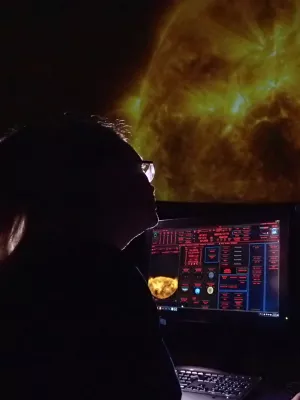
Anna Arnadottir
Research engineer

A Photometric Study of the Galactic Disks based on Strömgren Photometry
Author
Summary, in English
As a first step we test the abilities of the Stromgren photometric system, and find that it can accurately reproduce metallicities determined from high resolution spectroscopy. We trace standard sequences for dwarf stars in the c1 vs. (b-y) plane and the c1 vs. (v-y) plane and find them to be metallicity dependent. The possibility of developing a log(g) calibration from Stromgren uvby photometry is explored, but we find such calibrations unable to separate dwarf stars from sub-giant stars.
Five lines of sight have been observed with the Stromgren photometric system, all at intermediate galactic latitudes in the northern Galactic hemisphere. Stromgren photometry enables us to identify dwarf stars, dominantly located in the thin and the thick disks of the Galaxy, and to determine their metallicities. With accurate metallicity determinations we can infer absolute magnitudes for the dwarf stars using isochrones and thereby get stellar distances. We calculate the density along two of our lines of sight, and fitting a density model to the observed stellar number density we determine the scale-height of the thick and the thin disk along with the local normalisation of the two. The metallicity distribution function along our observed lines of sight is explored and we find it to be peaked at M/H of about -0.7 dex with a tail towards the metal poor. We study how the metallicity distribution function varies with distance from the Galactic centre and find no radial metallicity gradient in the thick disk. How the metallicity distribution function varies with height above the Galactic plane is also explored and we find a vertical metallicity gradient of -0.23 dex/kpc for G-type dwarf stars. We have some partial success at disentangling the thick disk metallicity distribution function from the thin disk metallicity distribution function and find no vertical metallicity gradient among thick disk stars.
Department/s
- Lund Observatory - Has been reorganised
Publishing year
2009
Language
English
Document type
Dissertation
Publisher
Lund Observatory, Lund University
Topic
- Astronomy, Astrophysics and Cosmology
Keywords
- density parameters
- formation.
- metallicity distribution function
- thin disk
- metallicities. Galaxy - thick disk
- colours
- Photometry - Strömgren
- luminosities
- SDSS. Stars - classification
Status
Published
Supervisor
- Sofia Feltzing
- Ingemar Lundström
ISBN/ISSN/Other
- ISBN: 978-91-628-7922-8
Defence date
23 November 2009
Defence time
14:15
Defence place
Lundmarkssalen, institutionen för astronomi, Sölvegatan 27
Opponent
- Bengt Edvardsson (docent)

